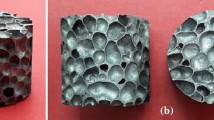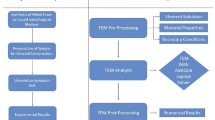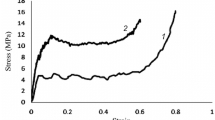Abstract
The deformation behaviour of two different types of aluminium alloy foam are studied under tension, compression, shear and hydrostatic pressure. Foams having closed cells are processed via batch casting, whereas foams with semi-open cells are processed by negative pressure infiltration. The influence of relative foam density, cell structure and cell orientation on the stiffness and strength of foams is studied; the deformation mechanisms are analysed by using video imaging and SEM (scanning electronic microscope). The measured dependence of stiffness and strength upon relative foam density are compared with analytical predictions. The measured stress versus strain curves along different loading paths are compared with predictions from a phenomenological constitutive model. It is found that the deformations of both types of foams are dominated by cell wall bending, attributed to various process induced imperfections in the cellualr structure. The closed cell foam is found to be isotropic, whereas the semi-open cell foam shows strong anisotropy.
Similar content being viewed by others
References
L. J. Gibson and M. F. Ashby, “Cellular Solids: Structure and Properties, ” 2nd ed. (Cambridge University Press, Cambridge, UK, 1997).
M. F. Ashby, A. G. Evans, J. W. Hutchinson and N. A. Fleck, “Metal Foams: A Design Guide” (Cambridge University, Engineering Department, Cambridge, UK, 1999).
A. G. Evans, J. W. Hutchinson and M. F. Ashby, “Current Opinion: Metals and Alloys” (1998) p. 288.
T. J. Lu, H. A. Stone and M. F. Ashby, Acta Mater. 46 (1998) 3619.
T. J. Lu and C. Chen, ibid. 47 (1999) 1469.
T. J. Lu, A. Hess and M. F. Ashby, J. Appl. Phys. 85(11) (1999) 7528.
X. Wang and T. J. Lu, J. Acous. Soc. Am. 106(2) (1999) 756.
H. P. Degischer, Materials and Design 18(4/6) (1997) 221.
C. Chen and T. J. Lu, Int. J. Solids Struc. 37 (2000) 7769.
C. Chen, T. J. Lu and N. A. Fleck, J. Mech. Phys. Solids 47 (1999) 2235.
V. S. Deshpande and N. A. Fleck, J. Mech. Phys. Solids, in press.
L. J. Gibson, M. F. Ashby, J. Zhang and T. C. Triantafillou, Int. J. Mech. Sci. 31 (1989) 635.
M. A. Puso and S. Govindjee, ASME MD 68 (1995) 159.
J. Zhang, Z. Lin, A. Wong, N. Kikuchi, V. C. Li, A. F. Yee and G. S. Nusholtz, J. Engng. Mater. Tech. 119 (1997) 284.
Y. Sugimura, J. Meyer, M. Y. He, H. Bart-Smith, J. Grenestedt and A. G. Evans, Acta Mater. 45 (1997) 5245.
K. Y. G. McCullough, N. A. Fleck and M. F. Ashby, Acta Mater. 47 (1999) 2323.
H. L. Schreyer and Z. Chen, ASME J. Appl. Mech. 53 (1986) 791.
R. H. J. Peerlings, R. De Borst, W. A. M. Brekelmans, J. H. P. De Vree and I. Spee, Eur. J. Mech. A/Solids 15 (1996) 937.
Author information
Authors and Affiliations
Rights and permissions
About this article
Cite this article
Lu, T.J., Ong, J.M. Characterization of close-celled cellular aluminum alloys. Journal of Materials Science 36, 2773–2786 (2001). https://doi.org/10.1023/A:1017977216346
Issue Date:
DOI: https://doi.org/10.1023/A:1017977216346




